

Portulak. Portulak ist ein wucherndes Garten-Unkraut, das man als Salat essen kann.

Daher wird der Portulak auch manchmal gezielt angebaut. Der Portulak hat ausserdem Heilwirkungen. Er kann Kopfschmerzen lindern und hilft bei anderen Nervenproblemen. Durch seinen Vitamin-C-Gehalt wirkt er auch gegen Skorbut und vitaminmangel-bedingte Zahnfleischentzündungen. Steckbrief Anwendung Den Portulak verwendet man am besten frisch als Salat oder Gemüse. Most Nutritionally Rich Vegetables. Through traditional plant breeding methods (not genetic engineering), scientists have been able to create super-nutritious varieties of fruits and vegetables.
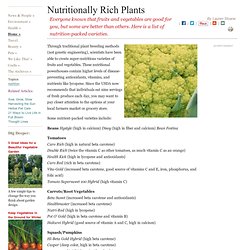
These nutritional powerhouses contain higher levels of disease-preventing antioxidants, vitamins, and nutrients like lycopene. Since the USDA now recommends that individuals eat nine servings of fresh produce each day, you may want to pay closer attention to the options at your local farmers market or grocery store. Some nutrient-packed varieties include: Beans Hystyle (high in calcium) Disoy (high in fiber and calcium) Bean Festina. Spaghetti squash. The spaghetti squash (Cucurbita pepo var. fastigata) (also called vegetable spaghetti, noodle squash, vegetable marrow, spaghetti marrow, and squaghetti) is an oblong seed-bearing variety of winter squash.

The fruit can range either from ivory to yellow or orange in color. The orange varieties have a higher carotene content. Its center contains many large seeds. Guide to Winter Squash. Winter squashes are the ultimate, easy-care vegetable, especially after they are harvested.

They let you enjoy homegrown goodness well into winter without having to dry, can, or freeze them: Just put the squashes in a dark, cool place and forget about them. Until, of course, you're ready to warm up with a creamy soup or savory pie. Contrary to their name, winter squashes are grown at the height of the summer season. They are abundant in stores and farmers' markets throughout the fall, so now is the perfect time to go squash exploring.
A squash worthy of a taste-test should be firm, feel heavy for its size, and not have huge blemishes or gouges. All winter squashes belong to the cucurbit family (also home to cucumbers and zucchini). Short-Season Favorite Acorn (C. pepo) Have a short growing season? Southern gardeners will also do well by acorns--you can get them in and out of the garden and still have time to make room for another crop. 9 Superfoods for Spring: Organic Gardening. It's spring—time to go green, literally.
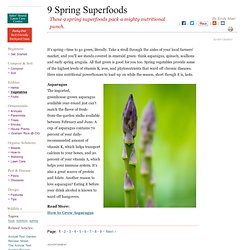
Take a stroll through the aisles of your local farmers' market, and you'll see stands covered in emerald green: think asparagus, spinach, scallions and early spring arugula. All that green is good for you too. 10 Mood-Boosting Foods You Can Grow: Organic Gardening. Just being outside, whether you’re gardening, exercising, or simply taking a stroll, is a great mood booster.
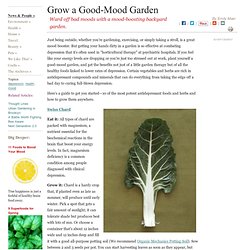
But getting your hands dirty in a garden is so effective at combating depression that it’s often used in “horticultural therapy” at psychiatric hospitals. If you feel like your energy levels are dropping or you’re just too stressed out at work, plant yourself a good-mood garden, and get the benefits not just of a little garden therapy but of all the healthy foods linked to lower rates of depression. Certain vegetables and herbs are rich in antidepressant compounds and minerals that can do everything from taking the edge off a bad day to curing full-blown depression. Salad Greens: Not Just Lettuce. Planting, Growing & Harvesting Broccoli. Broccoli is a great choice for a home garden.
Freshly cut broccoli heads are rich in vitamins and minerals. They’re delicious raw in salads or lightly steamed and they freeze well. If you choose a variety such as ‘DiCicco’ or ‘Waltham’ that produces plentiful side shoots, you can enjoy several cuttings from each plant in your garden. Best of Organic Gardening's 2011 Test Garden: Tomatoes. Tomatoes always figure prominently in the Organic Gardening Test Garden.
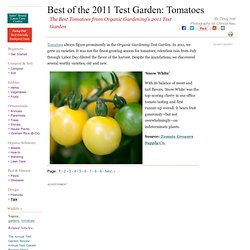
In 2011, we grew 22 varieties. It was not the finest growing season for tomatoes; relentless rain from July through Labor Day diluted the flavor of the harvest. Despite the inundations, we discovered several worthy varieties, old and new. ‘Snow White’ With its balance of sweet and tart flavors, ‘Snow White’ was the top-scoring cherry in our office tomato tasting and first runner-up overall. Source: Tomato Growers Supply Co. How to Grow Radishes: Easy Growing Guide. How to Grow Spinach. Spinach is one of the most satisfying cool-weather crops to grow, producing large yields of vitamin-rich, dark green leaves that are excellent for salads and for cooking.
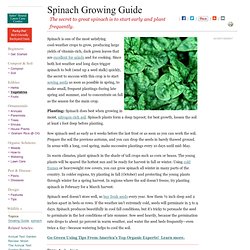
Since both hot weather and long days trigger spinach to bolt (send up a seed stalk) quickly, the secret to success with this crop is to start sowing seeds as soon as possible in spring, to make small, frequent plantings during late spring and summer, and to concentrate on fall as the season for the main crop. Planting: Spinach does best when growing in moist, nitrogen-rich soil. Spinach plants form a deep taproot; for best growth, loosen the soil at least 1 foot deep before planting.
Sow spinach seed as early as 6 weeks before the last frost or as soon as you can work the soil. Prepare the soil the previous autumn, and you can drop the seeds in barely thawed ground. GrowVeg: Here's a simple way to mak... How to Grow Carrots. How to Grow Carrots Orange carrots are the traditional standard, but you can try growing white, yellow, crimson, or even purple-skinned carrots, too.

More important than color, though, is choosing the right root size and shape to suit your soil.